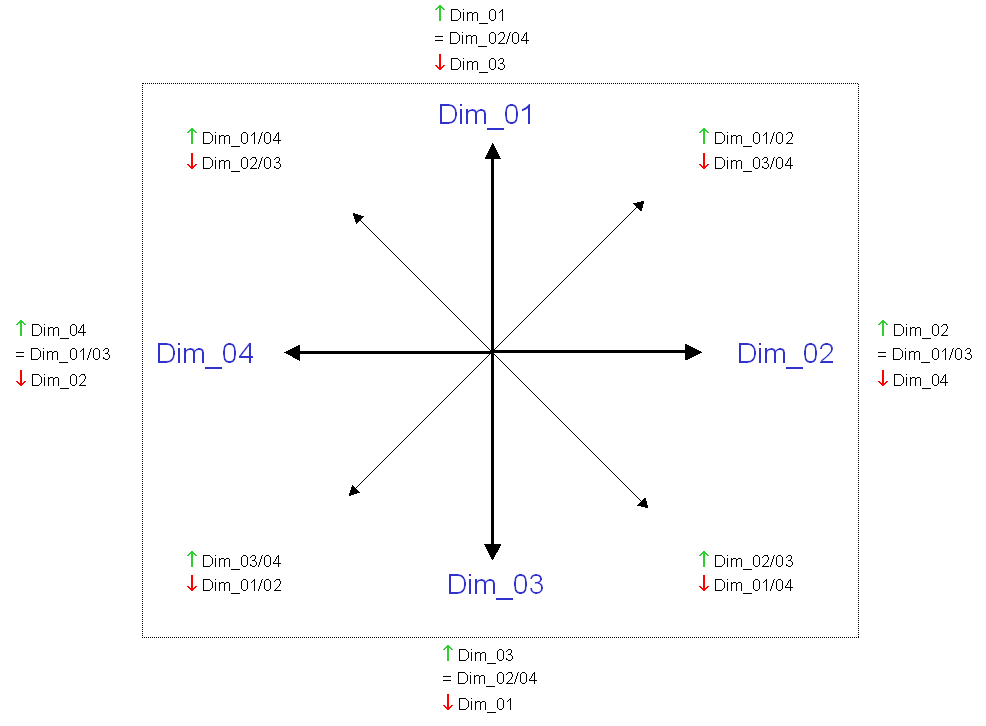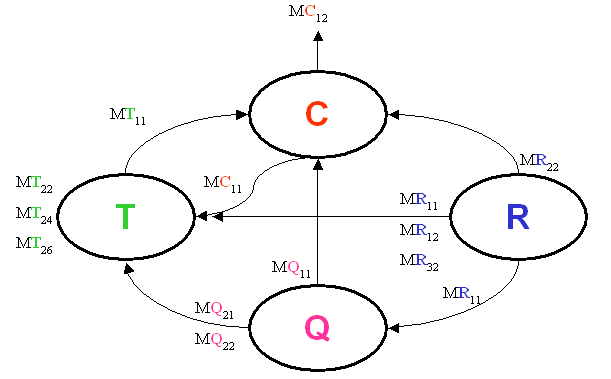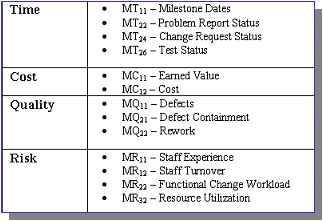
BMP (Balancing Multiple Perspectives) is a procedure with the aim to help project managers to choose a set of project indicators from several concurrent viewpoints. The four steps to perform are:
1) Determine the dimensions of interest in the project: at least three dimensions - four or five - would be a good idea, such as in EFQM, Baldrige, BSC;
2) Determine the list of the most representative measures associated with each dimension;
3) For each of the measures selected, identify which other control variables might be impacted negatively (e.g. counter-productive impacts: for instance, higher quality will often mean a greater initial cost or longer project duration; the same applies to cost and risk;
4) Figure out the best combination of indicators and the causal relations between them in order to build a measurement plan for the project.
This is an example of a generic BMP template taking into account 4 possible dimensions of analysis, with the positive (![]() ), neutral (=) or negative (
), neutral (=) or negative (![]() ) impacts:
) impacts:

and this is an example of instantiation of BMP - having chosen Time (T), Cost (C), Quality (Q) and Risk (R) as the four perspectives - with possible causal relationships from a selected list of metrics (just 13 out of an initial list of 67, see PSM Guide v4.0b):


Benefits applying BMP
Main benefits from the application of BMP can be:
 enlarge the "tracking & control" usual scope to more than the usual two perspectives (Time and Cost), having more inputs for cause-effects analysis
enlarge the "tracking & control" usual scope to more than the usual two perspectives (Time and Cost), having more inputs for cause-effects analysis
 have a starting point for building your own "strategic map", as in the BSC logic
have a starting point for building your own "strategic map", as in the BSC logic
 put in place a more granular view on the ROI from "tracking & control" mechanisms and introduce/maintain a balanced number of controls on your processes, changing the said "the more you measure, the more you control" into "the better you measure, the more you control".
put in place a more granular view on the ROI from "tracking & control" mechanisms and introduce/maintain a balanced number of controls on your processes, changing the said "the more you measure, the more you control" into "the better you measure, the more you control".
Experimentation/Trial
We are conducting trials with BMP: we have prepared a questionnaire and a basic set of 14 analysis indicators for having the main goals to focus on:
 the # of perspectives and metrics (chosen and desired) and how they could be influenced by respondents' role
the # of perspectives and metrics (chosen and desired) and how they could be influenced by respondents' role
 the analysis of causal relationships among processes, using metrics in a Balanced Scorecard logic
the analysis of causal relationships among processes, using metrics in a Balanced Scorecard logic
 the costs for �tracking & control� process within the organization
the costs for �tracking & control� process within the organization
 the Questionnaire is available in several languages (currently in English, Italian, German, French, Turkish) in order to facilitate the comprehension by interested people
the Questionnaire is available in several languages (currently in English, Italian, German, French, Turkish) in order to facilitate the comprehension by interested people
Those interested in applying it to their organization can contact us for receiving assistance simply in change of the returned filled questionnaires (yet anonymized) for increasing our database for further analysis and approfoundishments on this issue, "redistributed" through technical reports and publications.
Publications:
 L.Buglione & A.Abran, Multidimensional Project Management Tracking & Control - Related Measurement Issues, Proceedings of SMEF 2005, Software Measurement European Forum, 16-18 March 2005, Rome (Italy), pp. 205-214
L.Buglione & A.Abran, Multidimensional Project Management Tracking & Control - Related Measurement Issues, Proceedings of SMEF 2005, Software Measurement European Forum, 16-18 March 2005, Rome (Italy), pp. 205-214
![]()
![]()
 L.Buglione & A.Abran, Improving Measurement Plans from multiple dimensions: Exercising with Balancing Multiple Dimensions - BMP, 1st Workshop on "Methods for Learning Metrics", METRICS 2005, 11th IEEE International Software Metrics Symposium, 19-22 September 2005, Como(Italy)
L.Buglione & A.Abran, Improving Measurement Plans from multiple dimensions: Exercising with Balancing Multiple Dimensions - BMP, 1st Workshop on "Methods for Learning Metrics", METRICS 2005, 11th IEEE International Software Metrics Symposium, 19-22 September 2005, Como(Italy)
![]()
![]()
 R.Dumke, A.Abran & L.Buglione, Suggestions for Improving Measurement Plans: First Results from a a BMP Application, Proceedings of SMEF 2006, 3rd Software Measurement European Forum, 10-12 May 2006, Rome (Italy), pp. 209-224
R.Dumke, A.Abran & L.Buglione, Suggestions for Improving Measurement Plans: First Results from a a BMP Application, Proceedings of SMEF 2006, 3rd Software Measurement European Forum, 10-12 May 2006, Rome (Italy), pp. 209-224
![]()
![]()
 L.Buglione & A.Abran, Improving Measurement Plans from multiple dimensions: Exercising with Balancing Multiple Dimensions - BMP, 2005, reprinted in "Projects & Profits", July 2006, ICFAI University Press, pp.11-16
L.Buglione & A.Abran, Improving Measurement Plans from multiple dimensions: Exercising with Balancing Multiple Dimensions - BMP, 2005, reprinted in "Projects & Profits", July 2006, ICFAI University Press, pp.11-16
 Buglione L., Gencel G. & Efe P., Suggestions for Improving Measurement Plans: a BMP application in Turkey, Proceedings of IWSM / Metrikon 2006, Potsdam (Germany), November 2-4, 2006, Shaker Verlag, ISBN 3-8322-5611-3, pp. 203-227
Buglione L., Gencel G. & Efe P., Suggestions for Improving Measurement Plans: a BMP application in Turkey, Proceedings of IWSM / Metrikon 2006, Potsdam (Germany), November 2-4, 2006, Shaker Verlag, ISBN 3-8322-5611-3, pp. 203-227
![]()
 Cuadrado-Gallego J.J., Buglione L. & Rodriguez D., Suggestions for Improving Measurement Plans: A BMP application in Spain, Proceedings of the 4th Software Measurement European Forum (SMEF 2007), Rome (Italy), May 9-11 2007
Cuadrado-Gallego J.J., Buglione L. & Rodriguez D., Suggestions for Improving Measurement Plans: A BMP application in Spain, Proceedings of the 4th Software Measurement European Forum (SMEF 2007), Rome (Italy), May 9-11 2007
![]()